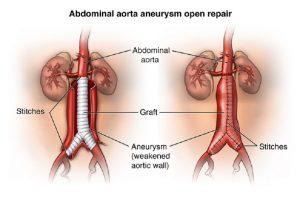Abdominal Aortic Aneurysm (AAA) repair to treat an aneurysm. An aneurysm is a bulging, weak spot in the aorta that may be at risk for rupturing. In this case, the aneurysm is in part of the aorta that is in the abdomen.
Endovascular aneurysm repair (EVAR), is a type of endovascular surgery used to treat pathology of the aorta, most commonly an aortic aneurysm (AA) in the Descending Aorta.
The descending aorta is part of the aorta, the largest artery in the body. The descending aorta begins at the aortic arch and runs down through the chest and abdomen. The descending aorta anatomically consists of two portions or segments, the thoracic and the abdominal aorta, in correspondence with the two great cavities of the trunk in which it is situated. Within the abdomen, the descending aorta branches into the two common iliac arteries which serve the pelvis and eventually legs.
What is Aortic Aneurysm (AA)?
Aortic aneurysm (AA) is a localized enlargement of the aorta such that the diameter is greater than 3 cm or more than 50% larger than normal. They usually cause no symptoms, except during rupture. AA’s occur most commonly in those over 50 years old, in men, and among those with a family history. Additional risk factors include smoking, high blood pressure, and other heart or blood vessel diseases. Genetic conditions with an increased risk include Marfan syndrome and Ehlers-Danlos syndrome. Abdominal Aortic Aneurysm (AAA) are the most common form of aortic aneurysm.
What are the symptoms of an abdominal aortic aneurysm?
- Sudden pain in your abdomen or back.
- Pain spreading from your abdomen or back to your pelvis, legs, or buttocks.
- Clammy or sweaty skin.
- Increased heart rate.
- Shock or loss of consciousness.
How is EVAR Performed?
In the EVAR procedure, a thin catheter is inserted into the femoral artery through a small incision in the groin. The catheter is guided through this artery to the aneurysm so that the stent graft can be implanted there. The stent graft is made of metal mesh with a synthetic coating. Once the aneurysm is reached, the stent graft is expanded using a balloon at the tip of the catheter and then attached to the aorta. The catheter is then pulled out. The blood flows through the stent. This puts less pressure on the vessel wall, lowering the risk of the aneurysm getting bigger or rupturing.
The advantage of this type of repair is that there is no abdominal surgery. This technique is therefore safer than the traditional operation, and you need to spend less time in hospital.











